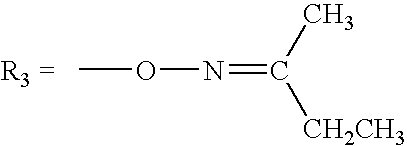Method of adhering decorative wheel cover to automobile wheel
- Summary
- Abstract
- Description
- Claims
- Application Information
AI Technical Summary
Problems solved by technology
Method used
Image
Examples
Embodiment Construction
[0028] As used herein, when a range such as 5-25 is given, this means preferably at least 5 and, separately and independently, preferably not more than 25.
[0029] As seen in FIG. 1, a wheel cover 10 is applied to a wheel rim 12 using a bonding material or cured adhesive layer 14, which is preferably based on a silicone-containing material, and more preferably an oxime silicone rubber-containing material. The adhesive layer 14 has spacer particles 21 dispersed throughout the layer to ensure that the adhesive layer has the appropriate uniform layer thickness as will be described in detail below. The adhesive layer 14 preferably has good flexibility characteristics, gap filling ability, shock and heat resistance, the ability to avoid embrittlement or other adverse effects of thermal cycling, and the ability to set up and cure without fixturing or otherwise mechanically retaining the wheel cover 10 and rim 12 in place. The adhesive layer material is preferably applied as an uncured silic...
PUM
 Login to View More
Login to View More Abstract
Description
Claims
Application Information
 Login to View More
Login to View More - R&D
- Intellectual Property
- Life Sciences
- Materials
- Tech Scout
- Unparalleled Data Quality
- Higher Quality Content
- 60% Fewer Hallucinations
Browse by: Latest US Patents, China's latest patents, Technical Efficacy Thesaurus, Application Domain, Technology Topic, Popular Technical Reports.
© 2025 PatSnap. All rights reserved.Legal|Privacy policy|Modern Slavery Act Transparency Statement|Sitemap|About US| Contact US: help@patsnap.com



